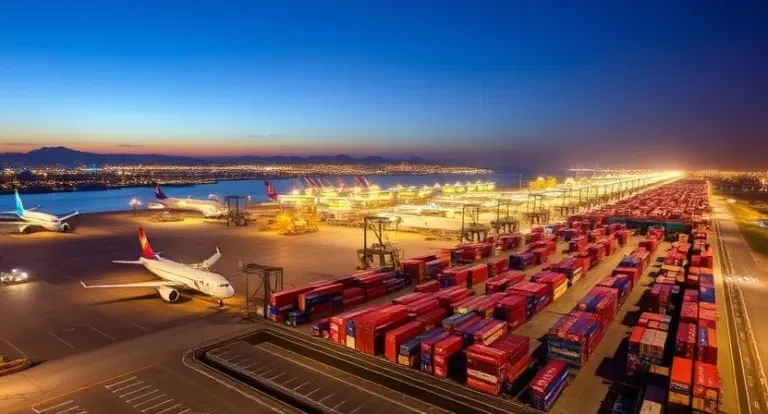What is the Difference Between Airport, Seaport, and Inland Container Depots in Terms of Export-Import Business

Simplify Your International Payments
Skip the complexity of traditional wire transfers with EximPe's smart payment solutions
Complete international transfers in hours, not days, with real-time tracking
Streamline BOE and Shipping Bill regularization online, and generate e-BRCs effortlessly.
Understanding logistics hubs plays a significant role in international trade, especially for successful export-import operations. Airports, seaports, and Inland Container Depots (ICDs) are three different facilities that serve different purposes when crossing borders. This paper deals with the differences between these facilities, focusing on their functions, advantages, and importance in the export-import business.
Overview of Logistics Hubs
Logistics hubs are essential elements of the supply chain that facilitate the movement of goods from the producers to the consumers. Each of the types has a different nature and purpose.
- Airports: Primarily constructed for air traffic, airports are more relevant to the transportation of high-value and time-sensitive goods quickly.
- Seaports: Since ships transport a huge amount of cargo, seaports are the most appropriate for bulk shipments.
- Inland Container Depots (ICDs): Located inland, ICDs are an extension of the seaports, which store and clear customs closer to the centres of production and consumption.
All these disparities are crucial for businesses engaged in international trade to make effective decisions concerning their logistics strategies.
Airports
Functionality
Airports are designed to handle air cargo operations, which include the loading and unloading of goods from aircraft. They are equipped with specialized facilities for customs clearance, security checks, and storage. Airports are particularly advantageous for transporting:
- Perishable Goods: Items like fruits, vegetables, and flowers that require quick transit times.
- High-Value Products: Electronics, jewellery, and pharmaceuticals that benefit from expedited shipping.
Advantages
- Speed: Air transport is the fastest mode of shipping available, allowing businesses to meet tight deadlines.
- Global Reach: Airports connect to a vast network of international destinations, facilitating global trade.
Disadvantages
- Cost: Air freight is typically more expensive than sea freight, making it less suitable for bulk shipments.
- Capacity Limitations: Airports have restrictions on the size and weight of cargo that can be transported.
Seaports
Functionality
Seaports are critical nodes in global trade networks where cargo ships dock to load and unload goods. They handle a wide range of products, including bulk commodities like oil and grain, as well as containerized cargo. Key functions include:
- Storage Facilities: Warehouses for temporary storage before distribution.
- Customs Clearance: Processing imports and exports through customs regulations.
Advantages
- Cost-Efficiency: Sea freight is generally more economical than air freight, especially for large volumes.
- Capacity: Seaports can accommodate large shipments and heavy cargo that cannot be transported by air.
Disadvantages
- Transit Time: Shipping by sea takes longer than air transport, which may not be suitable for time-sensitive goods.
- Congestion: Seaports can become congested during peak seasons, potentially delaying shipments.
Inland Container Depots (ICDs)
Functionality
An Inland Container Depot (ICD) acts as a dry port located inland from major seaports. It provides a range of services similar to those found at seaports but is positioned closer to production areas. Key functions include:
- Customs Clearance: ICDs facilitate customs inspections and clearances away from congested ports.
- Storage and Handling: They offer temporary storage for containers before they are transported to seaports or delivered inland.
Advantages
- Reduced Congestion at Ports: By decentralizing customs operations and providing clearance services closer to demand centres, ICDs alleviate pressure on seaports.
- Cost Savings: Businesses can save on transportation costs by using ICDs located near production facilities or urban centres.
Disadvantages
- Limited Capacity for Bulk Cargo: While ICDs are efficient for containerized shipments, they may not handle bulk cargo as effectively as seaports.
- Dependence on Connectivity: The efficiency of an ICD depends on its connectivity with railways and roads for onward transportation.
Comparing Airports, Seaports, and ICDs
To better understand how these logistics hubs differ in terms of their roles in the export-import business, consider the following comparison:
Final Thoughts
Now that you understand the differences between airports, seaports, and Inland Container Depots (ICDs) in the context of the export-import business, you can better navigate your logistics options. Ensure that you thoroughly evaluate each facility's capabilities based on your specific shipping needs—whether it's speed, cost-effectiveness, or capacity. By aligning your logistics strategy with the right type of hub and verifying all operational details, you can streamline your export-import processes efficiently.
Simplify Your International Payments
Skip the complexity of traditional wire transfers with EximPe's smart payment solutions
Lightning Fast
Complete international transfers in hours, not days, with real-time tracking
Bank-Grade Security
Multi-layer encryption and compliance with international banking standards
Global Reach
Send payments to 180+ countries with competitive exchange rates
Why Choose EximPe for International Payments?
EximPe Support
How can we help you with your global payments today?